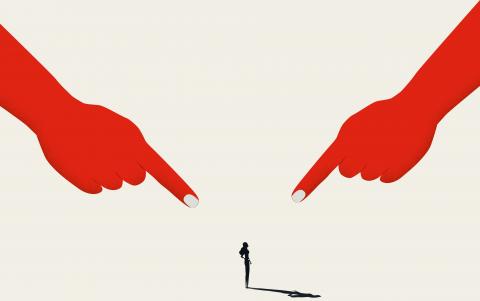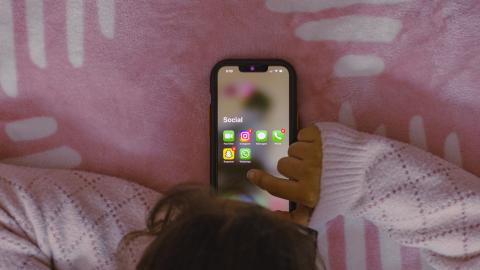Children and adolescents, who have been particularly affected by the consequences of the pandemic on their psychological well-being, have been facing for some time now the threat of harassment on social networks and messaging and, more recently, the dissemination of false images of a sexual nature created with artificial intelligence systems or deepfakes, as in the case reported by mothers in Almendralejo (Badajoz). On the occasion of World Mental Health Day on 10 October, the Science Media Center Spain organised an informative session with experts to talk about its characteristics, risks and possible solutions.
This experience of rejection and humiliation is one of the most painful experiences we can have, especially in adolescence. Moreover, the fact that it happens through social networks makes it more unpredictable and uncontrollable, and more stressful
Irene de la Vega
"We are seeing more and more episodes of abuse and harassment on social networks," said Irene de la Vega Rodríguez, a specialist in Clinical Psychology at the Institute of Psychiatry and Mental Health of the Hospital Clínico San Carlos and member of the Spanish Society of Clinical Psychology ANPIR. "This experience of rejection and humiliation is one of the most painful experiences we can have, especially in adolescence, when our identity is being formed. It is often experienced with a great sense of guilt, shame and a breakdown of trust in the world. Moreover, the fact that it happens through social networks makes it more unpredictable and uncontrollable, and therefore more stressful".
"What we traditionally called bullying is now also cyberbullying," explained Esther Calvete, professor of psychology at the University of Deusto and leader of the Deusto Stress Research team, which specialises in mental health, stress, anxiety and the effects of online bullying. The forms of victimisation are different: they can be between peers by peers, they can happen in couple relationships or even with older people pretending to be teenagers.
The latter "is what is known as grooming, and involves impersonation, which can be used to obtain sexual material from the victim. It is much more common than people think. We are finding that, on average, 10% of teenagers have been contacted," Calvete said. In general, "social networks have made harassment cases increase because they make it easier, allow anonymity and avoid face-to-face confrontation".
It is not just victimisation in the schoolyard, but is transmitted repeatedly and increases the sense of exposure and humiliation, generating much more anxiety and transformation of personal patterns
Esther Calvete
As for the new scenarios that artificial intelligence technologies are opening up, such as the dissemination of false images of a sexual nature, Calvete acknowledges that this is another step for which we are not yet prepared, but "the cyberbullying we have experienced in recent years also included manipulating photographs using tools such as Photoshop, and its impact is terrible. It is not just victimisation in the school playground, but it is transmitted repeatedly and increases the sense of exposure and humiliation, generating much more anxiety and transformation of personal patterns".
As to whether there are gender differences, Calvete stressed that "it is not a purely feminine issue, boys can also be affected". In the case of grooming, "girls are more often contacted by masked adults on the internet, but it also happens with boys, and they are more likely to fall into the trap and share material", she explained. In any case, "the most vulnerable gender identities and the ones that are classically more subject to victimisation are those of homosexual and transgender groups".
The impact of these situations, which is potentially very stressful, also "depends on the person and there are protective and vulnerability factors", explained De la Vega. The previous personal security situation or the reaction of the family and environment influence the response, but both experts agreed that "victimisation can make previously healthy and well-integrated people vulnerable".
Interventions should not only be aimed at preventing harm from occurring, but above all at preventing it from occurring: this is where the focus should be, on the perpetrator. It must be made clear that this is reprehensible
Esther Calvete
The solution cannot be a total ban on mobile phones, which among other things are an element of socialisation. "It is something that cannot be considered nowadays, we must learn to live with it and to regulate it, to get the maximum benefits in a balanced way", said Calvete. According to the expert, "social networks have many benefits, but we have to regulate the time spent on them, because the dangers increase as the time spent on them increases". Although the consequences are manifested on an individual level, "this is a public health problem to which we must provide a social and governmental response", stressed de la Vega.
In addition, the use of mobile phones is making it easier for children to have earlier access to pornographic materials, "and we have known for years that there is an association between the consumption of this type of material and the risk of sexual aggression, because they are often learning about sexuality through porn," explained Calvete. "What we have to do is provide sex education and get ahead of the curve. It is very difficult to completely restrict access to porn, but its impact will be less if they start from an educational base where they have seen healthy ways of relating sexually," he added.
In terms of possible educational interventions, both experts agreed that these should also take place online, that new technologies should be used to prevent possible risks from these same technologies. Moreover, "interventions should not only be aimed at preventing harm, but above all at preventing it from happening: this is where the focus should be, on the aggressor. It must be made clear that this is reprehensible," Calvete explained.
The group response to such events is very important and acts as a protective factor
Irene de la Vega
One type of intervention that is being practised with good results is the so-called "smart interventions", which are not presented as such, but as a request to adolescents. "We tell them that we do studies and research, that we have learned things about people's behaviour and that we need their help to pass this information on to people their age. We have found that they work very well, that they reduce aggression and that they help to control the circle of reactivity. Because many times there are not pure aggression and victims, but a give and take of response and aggression".
Finally, the experts gave some advice on what they would recommend to those who report this type of news. "In journalism, it is important to make it clear that this type of behaviour is serious, that it can do a lot of damage and that we must avoid the bystander effect. We must educate about this because the group's response to this type of event is very important and acts as a protective factor, it must be made clear that it will not be overlooked," explained de la Vega. In addition, "information should be treated in a similar way to what is recommended in cases of suicide, avoiding specific data and thus avoiding possible copycat effects", she added.
"The focus should be on the responsibility of the aggressor, and it should be made clear that there are other very healthy ways of using social networks. These alternative ways must be shown," Calvete concluded.




